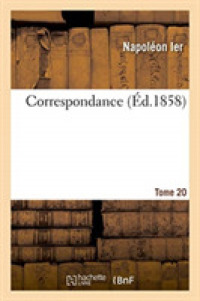Full Description
The last thirty years of intellectual and artistic creativity in the 20th century have been marked by gender issues. Translation practice, translation theory and translation criticism have also been powerfully affected by the focus on gender. As a result of feminist praxis and criticism and the simultaneous emphasis on culture in translation studies, translation has become an important site for the exploration of the cultural impact of gender and the gender-specific influence of cuture. With the dismantling of 'universal' meaning and the struggle for women's visibility in feminist work, and with the interest in translation as a visible factor in cultural exchange, the linking of gender and translation has created fertile ground for explorations of influence in writing, rewriting and reading.
Translation and Gender places recent work in translation against the background of the women's movement and its critique of 'patriarchal' language. It explains translation practices derived from experimental feminist writing, the development of openly interventionist translation strategies, the initiative to retranslate fundamental texts such as the Bible, translating as a way of recuperating writings 'lost' in patriarchy, and translation history as a means of focusing on women translators of the past.
Contents
1. Historical Background
The Women's Movement and the Idea of Gender
Women and Language
Gender and Translation
2. Gender and the Practice of Translation
Experimental Feminist Writing and its Translation
Translating the Body
Translating Puns of Cultural References
Translating Experiments with Language
Interventionist Feminist Translation
Translating Machismo
Assertive Feminist Translation
Recovering Women's Works 'Lost' in Patriarchy
Further Corrective Measures
3. Revising Theories and Myths
Proliferating Prefaces: The Translator's Sense of Self
Asserting the Translator's Identity
Claiming Responsibility for 'Meaning'
Revising the Rhetoric of Translation
Tropes
Achieving Political Visibility
Revising a Fundamental Myth
Pandora's Cornucopia
4. Reading and Rewriting Translations
Reading Existing Translations
Simone de Beauvoir
Rewriting Existing Translations
The Bible
Comparing 'Pre-feminist' and 'Post-feminist Translations
Sappho and Louise Labé
Recovering 'Lost' Women Translators
Subversive Activity in the English Renaissance
Nineteenth-Century Women Translators
La Malinche
5. Criticisms
Criticism from Outside Feminisms
Criticism from Within Feminisms
Elitist Experimentation
Opportunist Feminist Bandwagon
'Being Democratic with Minorities'
Revealing Women's Cultural and Political Diversity
6. Future Perspectives
Broad Historical Perspectives
Contemporary Perspectives
Public Language Policies
Interpreting
7. Concluding Remarks








